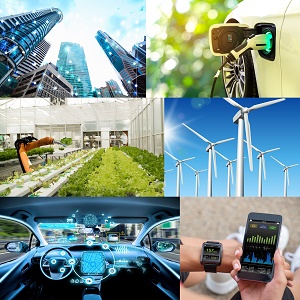
As a materials engineer, I am very proud of the fact that key advances in human civilization have been driven by materials innovation. The stone age, bronze age and iron age were all essential steps in setting the human race on the path that we are on today. Innovations are not without their downsides, but they have enabled progress in agriculture, medicine, transportation, communication, and other fields. In that context, I think few would argue that today we live in the silicon age. And I think that is something that everyone at Lam should take pride in.

Specialty Technologies bring functionality
Most us will be very familiar with silicon chip technologies such as memory and microprocessors, but some will be less familiar with the array of other silicon chips that make up the products, such as mobile phones, that are so central to our modern lives. Yet, advances in these other chips, which make up the camera, sensing systems, power management systems and RF connectivity solutions, are literally changing our lives one chip at a time.
Today, that single mobile phone is a high resolution digital camera, a video camera, a digital photo album and scrap book, a mini TV, a navigation system, a health tracker, a personal assistant, an instant messaging service, and, sometimes, we may even use it to make a phone call. And all this functionality owes as much to the Specialty Technology devices in the phone as it does the phone’s application processor and memory. It is interesting to note that in the latest generation iPhone 12, 73% of the silicon chip content by area is made up of Specialty Technology solutions manufactured at technology nodes ≥28 nm.

A broad range of applications
You do not have to think too hard about how phones have changed in just a few years to realize how these technologies have changed our lives. Advances in CMOS image sensor technologies have enabled high-resolution photography and video capture at a level that was only available in professional cameras just a few years ago. This is unlocking our creativity and documenting our lives in a way that has never previously been possible. Using 3D imaging we can even unlock our phones using facial recognition. And, as our phones become increasingly powerful and screens brighter and higher definition, advances in power management IC technologies have allowed battery lifetime and charging speeds to improve rather than suffer. Meanwhile, development of advanced 5G technology offers the promise of super-fast, low latency connectivity in an increasingly connected world.
And the pace of this innovation is speeding up, not declining. The time between early 2020 and today will of course be remembered most for the global COVID-19 pandemic. But it has also been a time of unprecedented human innovation and acceleration of technology trends driven by a need to adapt and to find new ways of working, shopping, and staying in touch with our loved ones. Technologies such as e-commerce, remote working, video communications and online entertainment have all advanced more in the past 18 months than they might have done in the next five years.
Underpinning all these advances are silicon chips, including Specialty Technologies, and this has increased the speed of development and significantly increased the demand for these solutions. That is one reason why the business outlook for the semiconductor industry is so strong. Even in the fight against COVID-19, Specialty Technologies such as MEMS sensors have been important in the development of temperature monitoring for detection, PCR solutions for testing, and even ventilators to support those that sadly fall seriously ill. Today we are lucky that we have not just one but several WHO-approved vaccinations for COVID-19 with many more in development or clinical trials. This is an incredible feat in such a short time frame. Prior to these vaccines, the record was four years. And none of this would have been possible without the incredible power of modern computing and sensing systems used in sequencing and tracking the virus’ genetic code and designing and simulating the vaccine drugs themselves. You see, silicon technology does not just advance in isolation, it has helped speed up the pace of innovation in every other field of medicine, science, and engineering.

At the heart of solutions
So, if semiconductor solutions and particularly Specialty Technologies can help to deal with human challenges such as COVID-19, what about other imperatives such as global warming? Well, almost certainly they will. Specialty Technologies are key to the development of electric and hybrid-electric cars, electric trains, delivery vehicles and in the future even electric planes and ships. These all depend upon advanced power semiconductors to manage the motor drives and charge the batteries. Advances in new semiconductor materials such as silicon carbide (SiC) and gallium nitride (GaN) will complement silicon technologies in these applications. And the same devices enable power conversion in renewable energy sources such as wind and solar.
But as we eliminate historic sources of greenhouse gas emissions, we need to be careful not to create new ones. I mentioned at the top of this blog that there are downsides to many technical advances no matter how much of a benefit they may be overall. And the age of silicon comes with its own challenges. As we become ever more dependent on data, we need to build vast server farms that consume huge amounts of power. This is going to be a very real challenge moving forward and one which we must take ownership of as an industry. With innovations that reduce the energy consumption of chips, the use of renewable energy sources, advanced power management technologies and integrated silicon photonic solutions there is a lot that we can do to help, and yet again Specialty Technologies will be at the heart of the solutions.